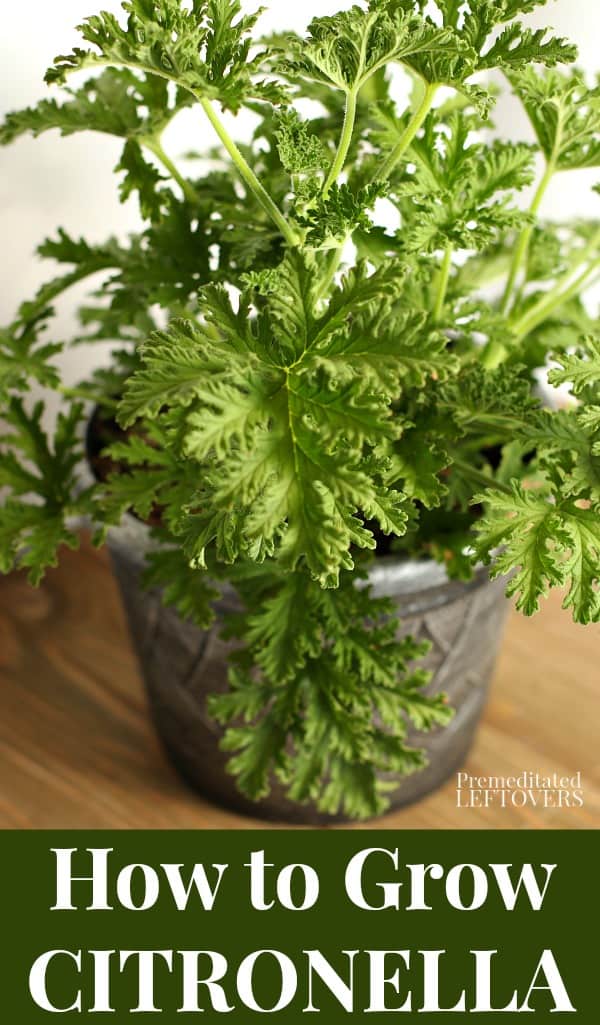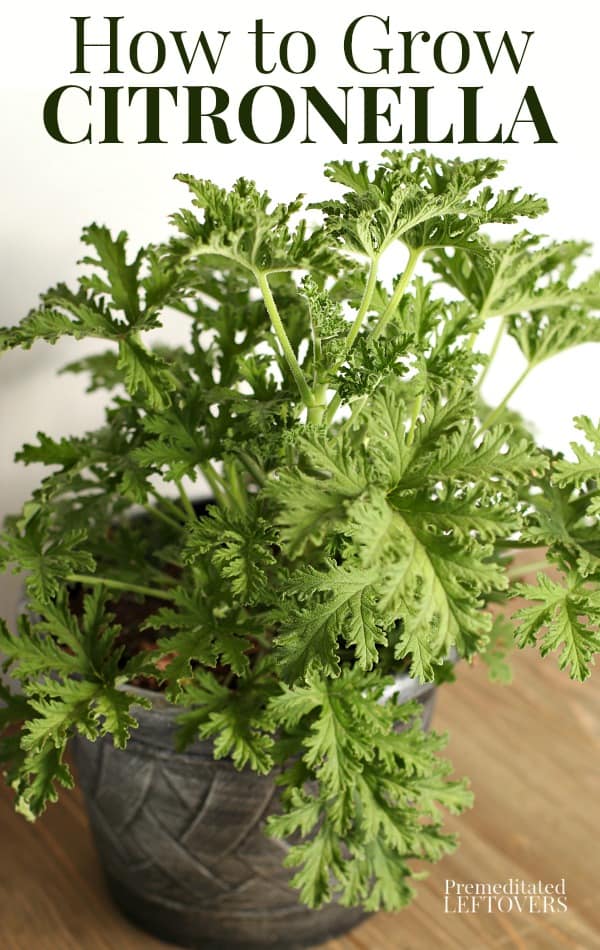Want a natural way to repel mosquitos? Use these gardening tips on how to grow Citronella to add this drought-tolerant plant to your yard.
Many people are familiar with the scent of citronella, as they can often catch a whiff of it coming from citronella candles and bug sprays that contain citronella oil. But before citronella makes its way into these products designed to repel pests, it starts off as a garden plant that looks great, smells great, and is super easy to grow. You don’t have to be a master gardener in order to know how to grow citronella, in fact, it is a simple plant that even a novice can enjoy.
Take a look at some helpful tips below on how to grow citronella with success, so you can enjoy all of the benefits this plant has to offer you, your home, and your garden.
The Benefits of Growing Citronella
Before we talk about how to grow citronella, let’s talk about all of the reasons why this plant is so awesome. Citronella is known for multiple benefits, which is why so many gardeners value it and enjoy planting it. Take a look at a few of the benefits of growing citronella below.
1. Citronella repels mosquitoes.
One of the most popular reasons that gardeners love to grow citronella is that it repels biting pests such as mosquitoes. To us, citronella smells amazing. To mosquitoes, it smells terrible. The citronella actually masks the scents that are mouthwatering to mosquitoes, sending them in a different direction. (http://npic.orst.edu/factsheets/citronellagen.html#howwork)
You can plant citronella plants in patio and deck pots where you tend to relax and socialize so that mosquitoes find another place to dine. Citronella can also be added to borders and beds around the home to help keep the yard mosquito-free.
2. Citronella has aromatherapy benefits.
The oil in the citronella plant can offer aromatherapy benefits including alleviation from stress and relief from tension headaches. While citronella essential oil is the most effective, just the scent of the crushed leaves can have a beneficial effect.
3. Citronella is forgiving.
While some plants can be finicky, citronella is not one of them. Citronella is quite forgiving and will do well whether you have a little space or a lot. Because it can be grown in containers or in the ground, the grower has options even if space is an issue.
4. Citronella makes a great companion plant.
If you like to grow tomatoes, citronella makes a great companion plant. When planted near tomato plants, citronella can help keep destructive pests away from the foliage as well as protect you from mosquitoes while you garden.
5. Citronella repels, it doesn’t kill, making it safe for wildlife.
When you use citronella plants or citronella oil to repel pests, you don’t have to worry about harming other wildlife. Pollinators such as bees, butterflies, and hummingbirds will not be harmed by it. This way, you can enjoy the benefits without having to worry about the other creatures in your yard. You can learn more about citronella oil here.
How to Grow Citronella
Now that you know about a few of the benefits of growing citronella, let’s talk about how to grow it! It is easy to find, easy to plant, and easy to enjoy. Let’s get started.
First, we will explore some of the basic questions that often arise when preparing to plant citronella. Whether you are planting in the ground or in a container, these tips will give you a good starting point.
What zone should citronella be grown in?
Citronella can grow all year round in zones 9-11. That means once you plant it, you can enjoy it for years to come. If you don’t live in one of these zones, don’t panic. You can place planters outdoors in the summer months and bring them indoors during the winter months. You must bring the plant indoors before the first frost of the season in order for it to survive inside during the cold months.
What kind of soil does citronella need?
Citronella is forgiving when it comes to soil. As long as the soil is well-draining, the plant should do well. Use nutrient-rich soil that allows water to run through it well. That way, the soil never becomes muddy which could drown the plant.
How much sun does citronella need?
Your citronella plant will do best if grown in six hours of sun per day. If you need to use a space that offers partial shade, the plant should still do well. Opt for planters or containers if you don’t have a plot of land that gets at least 6 hours of sun per day.
If growing indoors, your plant will benefit from just as much direct sun. A sunny window that enjoys at least 6 hours of sunlight per day is ideal.
How to Grow Citronella from Seed
If planting citronella from seed, you can do so directly outdoors after the final frost of the season. Or, you can start seeds indoors 6 weeks before the last frost of the season.
Citronella seeds are easy to grow because you can simply sprinkle the seeds over the loose soil. There is no need to bury them. Once sprinkled, you can add a very light scattering of soil over them. Then just water the seeds to help them settle into place.
If growing seeds indoors, cover the containers with plastic wrap to help retain heat and speed up the germination process. If planting directly outdoors, the 6+ hours of sun you are offering should get the sprouts springing up in no time.
Like other seedlings, citronella seedlings can be thinned out once the seedlings reach a few inches tall. This will help make way for the stronger plants, so the plants are not competing for nutrients.
How to Grow Citronella from Seedlings
You can find citronella in small seedling pots (typically 3-4 inch pots) at your local gardening center. These can easily be added to containers or directly into gardens, borders, window boxes, even hanging baskets.
To plant your seedlings, loosen up the soil in the container or ground. Dig a hole that is at least twice as deep and twice as wide at the roots of the plant. Place the roots of the seedlings into the hole making sure the base of the plant is level with the top of the soil/ground.
Place the seedling into the hole and fill in around the roots with soil. Water well. If you are planting additional citronella plants, make sure you space them at least 12-18 inches apart. Because citronella tends to bush out, you want to make sure they have ample room.
How to Grow Citronella from Cuttings
Yes, you can grow additional citronella plants from cuttings! This is a great way to get free plants.
Start with a sterilized pair of gardening shears or scissors. Cut 3-4 inches off the tip of the plant. Snip away all foliage on the stem except for the top 2-3 leaves. Press the cut end of the stem into rooting hormone, then press the stem into your prepared container. The container should include a nutrient-rich potting mix.
These cuttings will not want full sun right away. Keep them in a warm area, but not full sun, while the stems take root. You can water in order to keep the soil moist, but not muddy. Once the stems have taken root and are growing, you can proceed to the tips below.
How to Grow Citronella in Containers
To grow citronella in containers, start with a container that is at least 12 inches deep and wide. The container should be at least twice the width and twice as wide as the root of the plant.
Make sure there are proper drainage holes at the bottom of the container. Add holes if there aren’t any.
Add a few inches of nutrient-rich soil. Place the plant into the soil and fill in the space around the roots with additional soil. Water well and place the container in a sunny window that gets at least 6 hours of sun.
Additional citronella growing tips
These additional tips can help you enjoy success when it comes to your citronella plant. These tips are perfect for general care once your plant is in the ground (or container) and ready to grow!
- Use a liquid plant food upon planting and again every few weeks to keep your plant thriving.
- 1-2 inches of water per week, applied at the base of the plant, will help keep it nourished. If you plant your citronella outdoors, it will be quite drought tolerant and can survive extended periods of less than 2 inches of water per week.
- Two keep your citronella plant full, pinch off the ends of the plant every few weeks. This will act as pruning and help the plant bush out instead of becoming leggy.
Are you ready to start enjoying the benefits of citronella? As you can see, the benefits are many! Before you start planting, consider these tips on how to grow citronella. They can help you enjoy success so that you can appreciate your citronella plant for many years to come.



Carol bottorff says
Is it okay to use in a mixed planter…, like with geraniums, petunia & etc?
Barbara Corley says
I’m going to be 70 this year. I’ve grown house plants all my adult life I’ve also grown tomatoes, cumbersome and peppers. Nothing hard and mostly in containers. This year I’m planning to do more planting. Mainly in our yard. There is nothing but sand here but there is nothing else except weeds and trees. I want to plant around our porch plus do more potted plants and hanging baskets
Mary Rassy says
How can I make my Citronella to flower?
Than you.
Sue says
These directions are appropriate. I have several potted Citronella. Few flower, but the ones that do, have more morning sun than evening. Evening areas seem to need partial shade. My in-ground are in sun from noon til dusk & have not flowered. Also, Don’t overwater. They need to be dry before u water again, then watered heavy. Depending on the plant, they may not flower first year. Just an fyi, I’m in TN. & use them to keep deer & “critters” away from my flowering plants, too. Hope this helps.